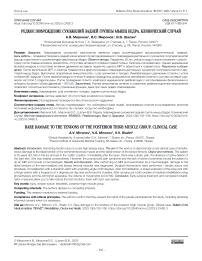Редкое повреждение сухожилий задней группы мышц бедра. Клинический случай
Автор: Миронов А.В., Миронов В.С., Шалин В.В.
Журнал: Вестник медицинского института "РЕАВИЗ": реабилитация, врач и здоровье @vestnik-reaviz
Рубрика: Клинический случай
Статья в выпуске: 5 т.13, 2023 года.
Бесплатный доступ
Введение. Повреждение сухожилий хамстрингов является редко встречающейся высокоэнергетической травмой.Цель работы - продемонстрировать редкий клинический случай одновременного повреждения дистального сухожилия полуперепончатой мышцы и дистального сухожилия двуглавой мышцы бедра.Объект и методы. Пациентка, 55 лет, упала на льду и села в положение «шпагат». Сразу после травмы возникла резкая боль, отсутствие активного сгибания правой голени. Лечилась консервативно. Однако выраженный болевой синдром и отсутствие активных движений заставили пациентку сделать МРТ и обратиться к травматологу.Результаты и обсуждение. После выполнения МРТ и осмотра травматолога диагностировано повреждение дистальных сухожилий полуперепончатой и двуглавой мышц бедра. Выполнено оперативные вмешательства - шов сухожилия и тенодез. Иммобилизация шарнирным тутором с углом сгибания 80 градусов. После иммобилизации в течении 6 недель проводилось дозированное разгибание коленного сустава системой шарниров частотой 5 градусов день. После проведения полного комплекса медицинской реабилитации с использованием физиолечения и аппарата Артромот объём движений - 0/0/180.Заключение. Раннее оперативное лечение и грамотные реабилитационные мероприятия позволяют полностью восстановить утраченные функции, даже при таких редких повреждениях.
Повреждение, шов сухожилия, тенодез, задняя группа мышц бедра
Короткий адрес: https://sciup.org/143181077
IDR: 143181077 | УДК: 617-089.844 | DOI: 10.20340/vmi-rvz.2023.5.CASE.3
Текст научной статьи Редкое повреждение сухожилий задней группы мышц бедра. Клинический случай
Хамстринги – это задняя группа мышц бедра, имеющая внутреннюю и наружную части. Наружная часть представляет собой длинную и короткую головки двуглавой мышцы бедра, а внутренняя включает в себя полуперепон-чатую и полусухожильную мышцы. Все три мышцы начинаются от седалищного бугра, за исключением короткой головки двуглавой мышцы, которая начинается от латеральной губы шероховатой линии бедренной кости. Идут по задней поверхности бедра и прикрепляются: наружная часть хамстринга к головке малоберцовой кости, внутренняя – к задней части мыщелка большеберцовой кости.
Участие хамстрингов в сгибании коленного сустава неоспорима. Важно помнить, что правильное сгибание коленного сустава требует участия обеих половин мышечного каркаса задней группы мышц бедра. Сокращение только внутренней части приводит к сгибанию и медиальной ротации коленного сустава, сокращение только наружной – к латеральной ротации соответственно. Однако без участия других ротаторов движения все равно будут нарушены.
Также хамстринги обеспечивают стабильность коленного сустава в качестве антагониста передней крестообразной связки. Участие в вальгусной и варусной стабильности неизвестно.
Повреждение одного из дистальных сухожилий приводит к резкому болевому синдрому, ограничению активных движения и развитию нестабильности коленного сустава.
Цель работы – демонстрация редкого клинического случая повреждения дистального сухожилия двуглавой мышцы бедра и полуперепончатой мышцы.
Объект и методы
Пациентка А., 55 лет, с её слов, поскользнулась на льду и села на «шпагат», почувствовала резкую боль по задней поверхности нижней трети правого бедра. В дальнейшем беспокоили резкая боль в данной области, ограничение активного сгибания в коленном суставе, хромота и наличие кровоподтека, распространяющегося по задней поверхности правой нижней конечности. С данными жалобами обратилась к травматологу Клинической больницы № 6 им. Г.А. Захарьина. После дообследования госпитализирована в плановом порядке для оперативного лечения в отделение травматологии № 1.
При внешнем осмотре отёк по задней поверхности нижней трети правого бедра. Массивный кровоподтёк багрово-красного цвета, распространяющийся до верхней трети бедра и средней трети голени (рис. 1). Активные движения в коленном суставе – 0/0/40. Пассивные движения – 0/0/180.
Данные лабораторных методов диагностики: Hb – 156 г/л, RBC - 5,0 x 10 9 л, Le - 6,0 x 10 9 л, СОЭ - 6 мм/ч. Общий анализ мочи: уд. вес – 1018, белок – 0,033 г / л, реакция – кислая, Le – 1–2 в п / зр, эпителий плоский – 0–2 в п / зр. Биохимический анализ крови: билирубин общий – 19,9 мкмоль / л, АЛТ – 28,0 Ед., АСТ – 20,0 Ед., креатинин – 98 ммоль / л, глюкоза – 6,75 ммоль / л, фибриноген – 2,42 г / л, ТВ – 16 с, МНО – 1,05, АПТВ – 32,8 с. Коагулограмма:
ПИ – 95 %, фибриноген – 312,1 г / л, МНО – 1,05. RW отрицательный. Гепатиты HBsAg, HCV не обнаружены. Анализ крови на ВИЧ: не обнаружен. Сахар крови: 4,3 ммоль / л.
Для полной постановки диагноза были выполнены: R-графия – без костно-травматической патологии. Данные МРТ: МР картина частичного повреждения двуглавой мышцы бедра и коллатеральной связки. Отёк параартикулярных тканей, преимущественно подколенной ямки. Умеренный синовит. Гонартроз 1 ст. При более тщательном исследовании был поставлен диагноз – разрыв дистального сухожилия длинной головки двуглавой мышцы бедра и отрыв от места прикрепления полуперепончатой мышцы (рис. 2).
Оперативное вмешательство выполнялось под эндо-трахеальным наркозом. Первым этапом выполнен линейный доступ 7 см по задне-латеральной поверхности правого бедра в проекции дистального конца длинной головки двуглавой мышцы бедра. При ревизии выявлен разрыв сухожилия в средней трети. Концы прошиты нитью FiberWire, концы сухожилий вшиты друг в друга для создания дупликатуры, дополнительное армирование капроновыми швами (рис. 3).
Вторым этапом выполнен разрез 8 см по заднемедиальной поверхности правого бедра так, чтобы разрез начинался от нижней трети бедра и заканчивался в верхней трети голени. При ревизии выявлен отрыв внутреннего пучка и разрыв среднего и наружного пучка у места трифуркации сухожилия полуперепончатой мышцы. Решено выполнить тенодез. Конец сухожилия прошит нитью FiberWare, в области медиального мыщелка большеберцовой кости подготовлено ложе для тенодеза. При помощи анкерного винта BioComposite SwiveLock сухожилие натянуто и фиксировано в костном канале (рис. 4).
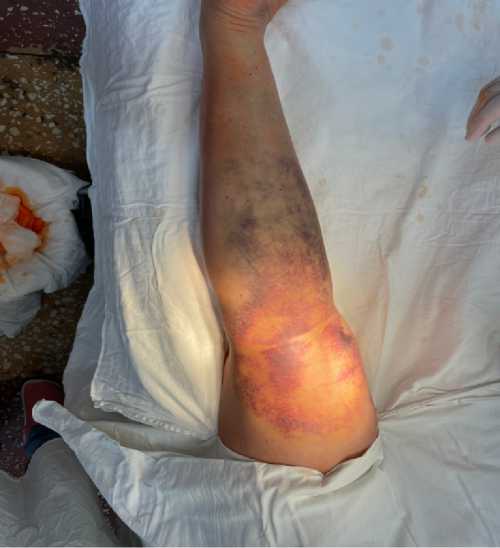
Рисунок 1. Внешний вид конечности до операции
Figure 1. Appearance of the limb before surgery
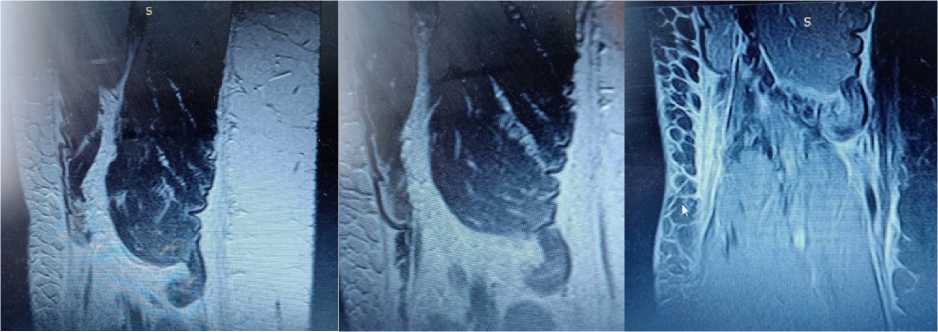
Рисунок 2. Данные МРТ
Figure 2. MRI data
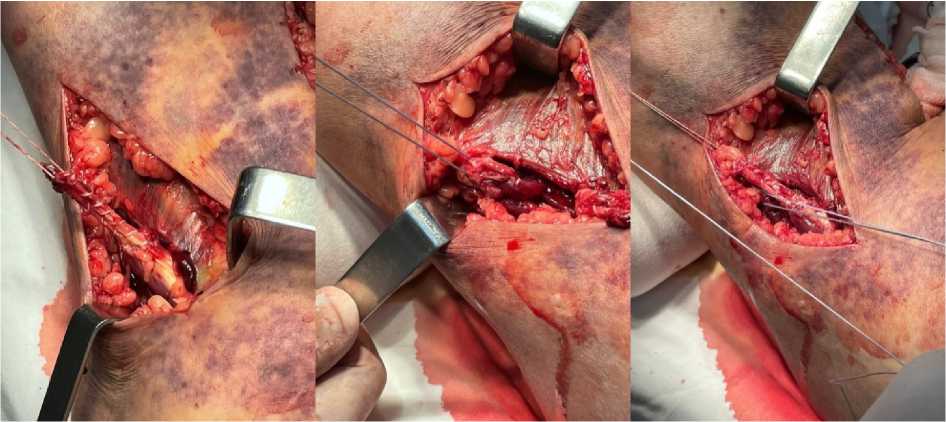
Рисунок 3. Шов сухожилия двуглавой мышцы бедра
Figure 3. Suture of the biceps femoral tendon
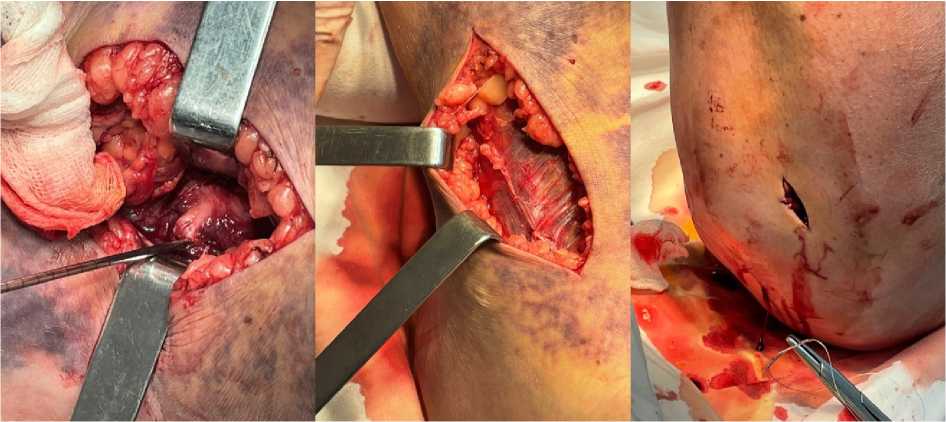
Рисунок 4. Тенодез сухожилия полуперепончатой мышцы
Figure 4. Tenodesis of the tendon of the semi-webbed muscle
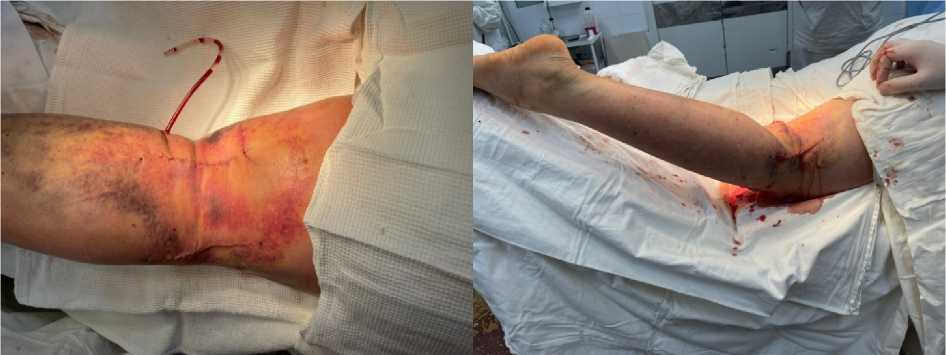
Рисунок 5. Вид послеоперационной раны и итоговое положение конечности
Figure 5. The type of postoperative wound and the final position of the limb
Учитывая давность травмы, оперативное вмешательство выполнялось в положении сгибания коленного сустава под углом 70–80 градусов. Раны послойно ушиты, коленный сустав фиксирован шарнирным тутором под углом 80 градусов (рис. 5).
За время нахождения в стационаре пациентка полу-чела антибактериальную терапию, нестероидные противовоспалительные препараты и антикоагулянты. Послеоперационный период протекал без осложнений. Пациентка выписана на амбулаторное лечение с рекомендациями.
Иммобилизация проводилась в течении 6-ти недель. В дальнейшем при помощи системы шарниров проводилось дозированное разгибание с частотой 5 градусов в неделю. В результате наличия стойкой смешанной контрактуры реабилитация заняла 6 месяцев. В отделении медицинской реабилитации проводился комплекс физиотерапевтического лечения (УВЧ, магнитотерапия, лазеротерапия) и применение аппарата Артромот. В конце лечения объём движений в коленном суставе составил 0/0/180.
Обсуждение
Повреждение мышц задней группы носит общее название хамстринг-синдром. Хамстринг-синдром включает в себя повреждение на любом уровне локализации. От вида и уровня травмы зависит тактика лечения.
При спазме мышц, сопровождающемся невритами седалищного нерва, применяются миорелаксанты. В качестве оперативного лечения используется либо парциальная, а при неэффективности и тотальная миотомия.
Повреждения хамстрингов можно разделить на три группы: тотальный или субтотальный разрыв сухожилий, отрыв от места прикрепления, отрывной перелом. При субтотальном разрыве применяют иммобилизационное лечение в положении сгибания для уменьшения мышечного напряжения. При тотальном разрыве используются сухожильные швы.
В результате отрыва от места прикрепления применяют две методики: тенодез и реинсерция. Тенодез используют при застарелых разрывах, реинсерция имеет место быть при свежих повреждениях. При отрывных переломах применяют остеосинтез винтами.
Заключение
В данном клиническом случае описано редкое проявление хамстринг-синдрома – одновременное повреждение сухожилий полуперепончатой и двуглавой мышц задней группы. Своевременное обращение, верно выбранная тактика лечения и ранняя реабилитация позволили в относительно короткие сроки восстановить объём движений поражённого сегмента.
Список литературы Редкое повреждение сухожилий задней группы мышц бедра. Клинический случай
- Ekstrand J, Krutsch W, Spreco A, Zoest W, Roberts C, Meyer T, Bengtsson H. Time before return to play for the most common injuries in professional football: a 16-year follow-up of the UEFA Elite Club Injury Study. British Journal of Sports Medicine. 2020;54(7):421-426.
- Wangensteen A, Tol JL, Witvrouw E, Linschoten R, Almusa E, Hamilton B, Bahr R. Hamstring reinjuries occur at the same location and early after return to sport: a descriptive study of MRI-confirmed reinjuries. The American Journal of Sports Medicine. 2016;44(8):2112-2121.
- Whiteley R, Massey A, Gabbett T, Blanch P, Cameron M, Conlan G, Ford M, Williams M. Match high-speed running distances are often suppressed after return from hamstring strain injury in professional footballers. Sports Health. 2021;13(3):290-295.
- Kenneally-Dabrowski CJB, Brown NAT, Lai AKM, Perriman D, Spratford W, Serpell BG. Late swing or early stance? A narrative review of hamstring injury mechanisms during high-speed running. Scandinavian Journal of Medicine and Science in Sports. 2019;29(8): 1083-1091.
- Jacobsen P, Witvrouw E, Muxart P, Tol JL, Whiteley R. A combination of initial and follow-up physiotherapist examination predicts physician-determined time to return to play after hamstring injury, with no added value of MRI. British Journal of Sports Medicine. 2016;50(7):431-439.
- Whiteley R, van Dyk N, Wangensteen A, Hansen C. Clinical implications from daily physiotherapy examination of 131 acute hamstring injuries and their association with running speed and rehabilitation progression. British Journal of Sports Medicine. 2018;52(5):303-310.
- Green B, Bourne MN, van Dyk N, Pizzari T. Recalibrating the risk of hamstring strain injury (HSI): a 2020 systematic review and meta-analysis of risk factors for index and recurrent hamstring strain injury in sport. British Journal of Sports Medicine. 2020;54(18):1081-1088.
- Van Dyk N, Farooq A, Bahr R, Witvrouw E. Hamstring and ankle flexibility deficits are weak risk factors for hamstring injury in professional soccer players: a prospective cohort study of 438 players including 78 injuries. The American Journal of Sports Medicine. 2018;46(9):2203-2210.
- Reurink G, Goudswaard GJ, Moen MH, Tol JL, Verhaar JA, Weir A. Strength measurements in acute hamstring injuries: intertester reliability and prognostic value of handheld dynamometry. Journal of Orthopaedic & Sports Physical Therapy. 2016;46(8):689-696.
- Hickey JT, Timmins RG, Maniar N, Rio E, Hickey P, Pitcher C, Williams M, Opar D. Pain-free versus pain-threshold rehabilitation following acute hamstring strain injury: a randomized controlled trial. Journal of Orthopaedic & Sports Physical Therapy. 2020;50(2):91-103.
- Hickey JT, Hickey PF, Maniar N, Timmins R, Williams M, Pitcher C, Opar D. A novel apparatus to measure knee flexor strength during various hamstring exercises: a reliability and retrospective injury study. Journal of Orthopaedic & Sports Physical Therapy. 2018;48(2):72-80.
- Urquhart MN, Bishop C, Turner AN. Validation of a crane scale for the assessment of portable isometric mid-thigh pulls. The Journal of Strength and Conditioning Research. 2018;26(5):28-33.
- Beyer EB, Lunden JB, Russell Giveans M. Medial and lateral hamstring response and force production at varying degrees of knee flexion and tibial rotation in healthy individuals. International Journal of Sports Physical Therapy. 2019;14(3):376-383.
- Thorborg K, Reiman MP, Weir A, Kemp J, Serner A, Mosler A, Holmich P. Clinical examination, diagnostic imaging, and testing of athletes with groin pain: an evidence-based approach to effective management. International Journal of Sports Physical Therapy. 2018;48(4):239-249.
- Macdonald B, McAleer S, Kelly S, Chakraverty R, Johnston M, Pollock N. Hamstring rehabilitation in elite track and field athletes: applying the British Athletics Muscle Injury Classification in clinical practice. British Journal of Sports Medicine. 2019;53(23):1464-1473.
- Ruddy JD, Pollard CW, Timmins RG, Williams MD, Shield AJ, Opar DA. Running exposure is associated with the risk of hamstring strain injury in elite Australian footballers. British Journal of Sports Medicine. 2018;52(14):919-928.
- Severini G, Holland D, Drumgoole A, Delahunt E, Ditroilo M. Kinematic and electromyographic analysis of the Askling L-Protocol for hamstring training. Scandinavian Journal of Medicine and Science in Sports. 2018;28(12):2536-2546.
- Van Dyk N, Behan FP, Whiteley R. Including the Nordic hamstring exercise in injury prevention programmes halves the rate of hamstring injuries: a systematic review and meta-analysis of 8459 athletes. British Journal of Sports Medicine. 2019;53(21):1362-1370.
- Ho IMK, Ng LPC, Lee KOL, Luk TCJ. Effects of knee flexion angles in supine bridge exercise on trunk and pelvic muscle activity. Research in Sports Medicine. 2020;28(4):484-497.
- Neto WK, Vieira TL, Gama EF. Barbell hip thrust, muscular activation and performance: a systematic review. Journal of Sports Science and Medicine. 2019;18(2):198-206.

